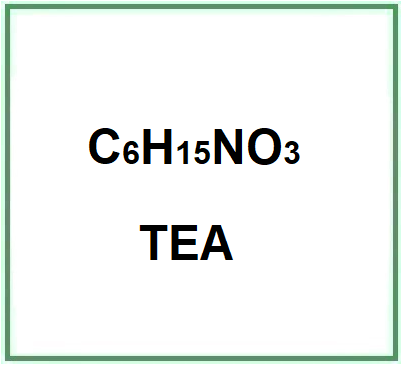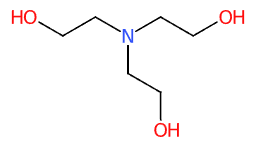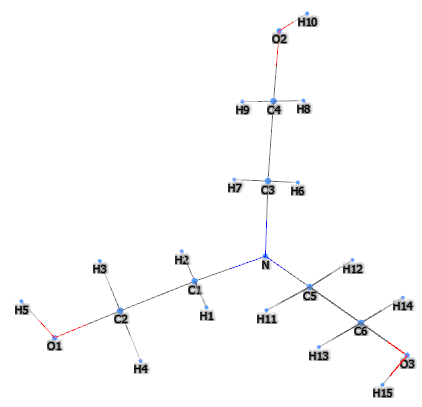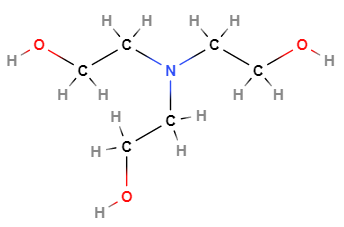TEA or Triethanolamine (2-[bis(2-hydroxyethyl)amino]ethanol), is a chemical compound, a triol and a tertiary amine compound derived from ammonia. It belongs to the ethanolamine family to which monoethanolamine (MEA) and diethanolamine (DEA) belong and was introduced to the market in 1920. Ethanolamines as amines react with acids to form soaps or salts and as alcohols can be esterified and are hygroscopic.
It occurs as a colourless liquid.
What it is used for and where
Cosmetics
Component added as a chemical intermediate for anionic and non-ionic surfactants, softening humectant and emulsifying agent in shampoos, lotions, creams and other cosmetics acting as a pH regulator.
Restricted cosmetic ingredient as III/62 a Relevant Item in the Annexes of the European Cosmetics Regulation 1223/2009. Substance or ingredient reported: Trialkylamines, trialkanolamines and their salts. Leave-on products and Rinse-off products: Do not use with nitrosating systems - Minimum purity: 99% - Maximum secondary amine content: 0.5% (applies to raw materials) - Maximum nitrosamine content: 50 microgram/kg - Keep in nitrite-free containers
Cosmetics - INCI Functions
- Buffering agent. It is an iingredient that can bring an alkaline or acid solution to a certain pH level and prevent it from changing, in practice a pH stabiliser that can effectively resist instability and pH change.
- Surfactant - Emulsifying agent. Emulsions are thermodynamically unstable and are used to soothe or soften the skin and emulsify, so they need a specific, stabilising ingredient. This ingredient forms a film, lowers the surface tension and makes two immiscible liquids miscible. A very important factor affecting the stability of the emulsion is the amount of the emulsifying agent. Emulsifiers have the property of reducing the oil/water or water/oil interfacial tension, improving the stability of the emulsion and also directly influencing the stability, sensory properties and surface tension of sunscreens by modulating the filmometric performance.
- Fragrance. It plays a very important role in the formulation of cosmetic products as it provides the possibility of enhancing, masking or adding fragrance to the final product, increasing its marketability. It is able to create a perceptible pleasant odour, masking a bad smell. The consumer always expects to find a pleasant or distinctive scent in a cosmetic product.
- Surfactant - Cleansing agent. Cosmetic products used to cleanse the skin utilise the surface-active action that produces a lowering of the surface tension of the stratum corneum, facilitating the removal of dirt and impurities.
Industry
Stabiliser and pH adjuster for the treatment of polyester surface aminolysis.
Other applications
Solvent and reagent. Used in detergents and household cleaning products, textiles, agricultural herbicides, mineral and vegetable oils, paraffin and waxes, pharmaceutical ointments, petroleum extraction, synthetic resins, plasticisers, adhesives and sealants.
Vulcanisation activator for natural and synthetic rubber, activator in the polymerisation of nitrile rubber.
Safety
It is considered a potentially toxic and pro-inflammatory compound (1).
The most relevant studies on this ingredient have been selected with a summary of their contents:
Triethanolamine studies
| Appearance | Colorless liquid |
| Boiling Point | 335.4±0.0 °C at 760 mmHg |
| Melting Point | 21°C |
| Flash Point | 185.0±0.0°C |
| Density | 1.2±0.1 g/cm3 |
Index of Refraction
| 1.511 |
Vapour Pressure
| 0.0±1.6 mmHg at 25°C |
Vapour density
| 5.14 |
| PSA | 63.93000 |
| LogP | -1.11 |
| Safety |
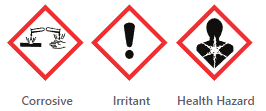 |
- Molecular Formula C6H15NO3 (HOCH2CH2)3N
- Molecular Weight 149.19
- Exact Mass 149.105194
- CAS 102-71-6
- UNII 9O3K93S3TK
- EC Number 203-049-8
- DSSTox Substance ID DTXSID9021392
- IUPAC 2-[bis(2-hydroxyethyl)amino]ethanol
- InChI=1S/C6H15NO3/c8-4-1-7(2-5-9)3-6-10/h8-10H,1-6H2
- InChl Key GSEJCLTVZPLZKY-UHFFFAOYSA-N
- SMILES C(CO)N(CCO)CCO
- MDL number MFCD00002855
- PubChem Substance ID 57653380
- ChEBI 28621
- ICSC 1034
- NSC 36718
- RTECS KL9275000
- Beilstein 1699263
- NACRES NA.25
Synonyms:
- Tris(2-hydroxyethyl)amine, 2,2′,2′′-Nitrilotriethanol
- Trolamine
- Tris(2-hydroxyethyl)amine
References_____________________________________________________________________
(1) Hu X, Zhou R, Li H, Zhao X, Sun Y, Fan Y, Zhang S. Alterations of Gut Microbiome and Serum Metabolome in Coronary Artery Disease Patients Complicated With Non-alcoholic Fatty Liver Disease Are Associated With Adverse Cardiovascular Outcomes. Front Cardiovasc Med. 2022 Jan 3;8:805812. doi: 10.3389/fcvm.2021.805812.
![]() TEA
TEA 

